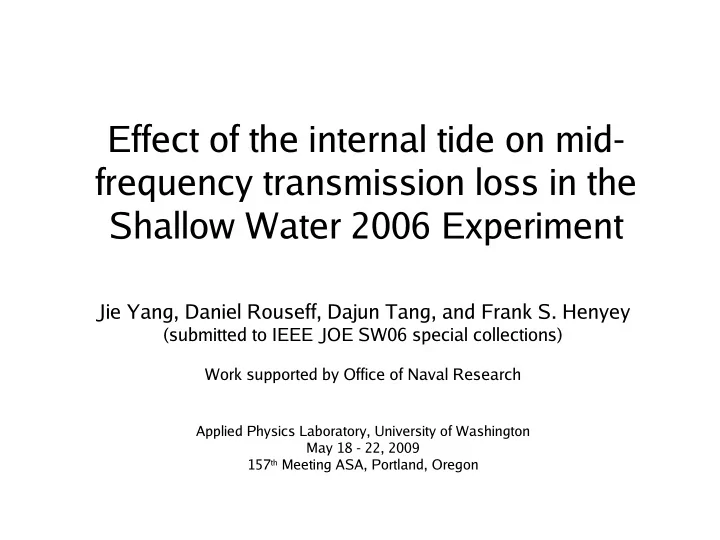

Effect of the internal tide on mid- frequency transmission loss in the Shallow Water 2006 Experiment Jie Yang, Daniel Rouseff, Dajun Tang, and Frank S. Henyey (submitted to IEEE JOE SW06 special collections) Work supported by Office of Naval Research Applied Physics Laboratory, University of Washington May 18 - 22, 2009 157 th Meeting ASA, Portland, Oregon
Goal Model mean TL at mid frequencies under slowly time varying conditions due to the internal tide.
Outline • Ocean data/modeling using multiple mooring data for mid-frequency acoustic modeling. • Two acoustic data sets and corresponding broadband PE simulation results: 1. fixed range (550 m) data 2. towed source data (max 8.1 km) • Summary and implications.
Geometry for acoustic measurements and oceanographic moorings 4
Sound speed recorded from mooring 54 for 18-19 August
Acoustic data I: 550 m fixed range intensity, receiver depth 25 m, 1.5 – 6 kHz
Group 1: Bottom Bottom Surfac direct + surface + bounc - e- direct e surface bottom
Group 1: Bottom Bottom Surfac direct + surface + bounc - e- direct e surface bottom Phase 1: 3 arrivals in group 1 well separated, arrival time relatively stable
Group 1: Bottom Bottom Surfac direct + surface + bounc - e- direct e surface bottom Phase 1: 3 arrivals in group 1 well separated, arrival time relatively stable Phase 2: group 1 getting more compact; earliest arrival time shifts toward bottom bounce.
Group 1: Bottom Bottom Surfac direct + surface + bounc - e- direct e surface bottom Phase 1: 3 arrivals in group 1 well separated, arrival time relatively stable Phase 2: group 1 getting more compact; earliest arrival time shifts toward bottom bounce. Phase 3: group 1 widens as thermocline being depressed before the nonlinear NLIW internal wave Rouseff et al., JASA-EL
Simulation strategy • Goal: develop a range-independent acoustic model to simulate observed arrival structure. • Approach: broadband Parabolic Equation simulation. • Example: Fourier synthesis of PE runs in 1.5 - 6 kHz with pulse length 400 ms using a CTD profile from the KNORR.
Acoustic data versus broadband PE simulation (CTD input, receiver depth 25 m, 1.5 – 6 kHz)
Acoustic data versus broadband PE simulations (cont’d) White: mooring data; magenta: CTD. (Receiver depth 25 m, 1.5 – 6 kHz)
Data/model comparison of acoustic intensity of the first arrival group Receiver depth 25 m, 1.5 – 6 kHz 6 4 2 0 Intensity (dB) -2 -4 -6 Raw data -8 Low-pass filtered data PE simulation -10 15 16 17 18 19 20 21 22 23 Time (hour)
Intensity 20-21 hour, Overall of 5 dB increases poor agreement intensity change between 16 to 19 when the wave before/after the 6 hours passes wave 4 2 0 Intensity (dB) -2 -4 -6 Raw data -8 Low-pass filtered data PE simulation -10 15 16 17 18 19 20 21 22 23 Time (hour)
Geometry for acoustic measurements and oceanographic moorings 16
Acoustic data II: towed source data at receiver depth 25 m, 1.5 – 6 kHz
10 20 30 Depth (m) 40 50 60 70 80 0 500 1000 1500 2000 2500 3000 Range (m) Launch angle upward Launch angle downward 10 0 20 0.5 30 1 Range (km) Depth (m) 40 1.5 50 2 60 2.5 70 3 80 -20 -10 0 10 20 0 500 1000 1500 2000 2500 3000 Reduced time (ms) Range (m)
0 10 20 30 Depth (m) 40 50 60 70 80 0 500 1000 1500 2000 2500 3000 Range (m) Launch angle upward Launch angle downward 0 0 10 0.5 20 1 Range (km) 30 Depth (m) 1.5 40 50 2 60 2.5 70 3 80 -20 -10 0 10 20 0 500 1000 1500 2000 2500 3000 Reduced time (ms) Range (m)
Reduced transmission loss at receiver depth 25 m with 1 kHz bandwidth
Modeling strategy roadband PE simulations se Mooring 54 for SSPs. reak 8.5 h data into 27 20-min windows. verage SSP over the window. esult: range-independent, slowly varying
Progress of sound speed profiles using Mooring 54 over 8 h period 0 Mean SSP 1 Mean SSP 7 Mean SSP 13 Mean SSP 19 Mean SSP 25 00:30 02:30 04:30 06:30 08:30 0.1 km 1.8 km 3.8 km 5.7 km 7.5 km 10 20 30 Depth (m) 40 50 60 70 80 1490 1500 1510 1520 1530 1500 1510 1520 1530 1500 1510 1520 1530 1500 1510 1520 1530 1500 1510 1520 1530 Sound speed (m/s)
Data/model comparison of reduced transmission loss receiver depth 25 m, 2.5 kHz ± 1 kHz bandwidth
Summary Acoustic Data and Modeling Acoustical effects of the rising thermocline: 1. 550 m data: changing arrival pattern and 5 dB change in acoustic intensity. 2. Towed source data: 2 dB change in acoustic intensity. Broadband PE together with range- independent / slow time-varying ocean model captures gross characteristics of TL. 1. At 550 m, good model/data agreement for both intensity and arrival pattern. 2. For towed source, overall good agreement.
Implications • Acoustical effects of the rising thermocline are significant, observable, and predictable. • Nearby mooring data improve acoustic modeling. • The observed acoustic variations due to the internal tide impacts geoacoustic inversion.
Recommend
More recommend